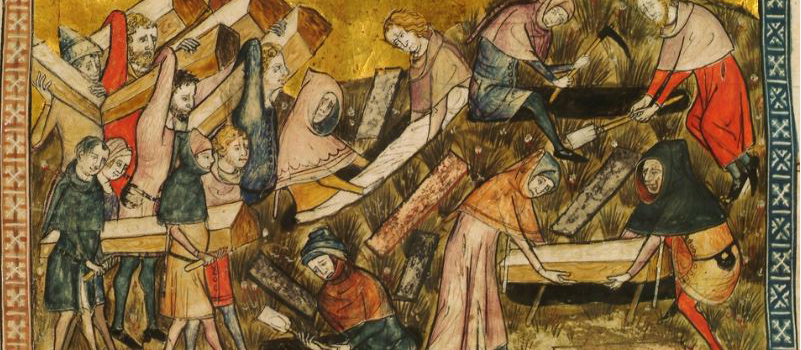By Daniel Sims
There have been many other pandemics and epidemics throughout human history, including The Black Death, represented in the above photo, which contributed to the end of feudalism in the Middle-Ages by killing around half of Europe's total population. Photo credit: Belgian Art Links and Tools.
We are currently living through a pandemic. Since I am currently teaching courses on Canadian environmental history and post-Confederation Canadian history, I jokingly told my classes the other day that they are getting the worst kind of experiential learning. Students who wondered about the responses to numerous epidemics and pandemics in Canadian history now have a better understanding of why people do not always act logically or altruistically during times of disease.
In particular, my students are now better equipped to understand a central tenet of environmental history: humans are not always the most important factor in human history. Epidemics and pandemics highlight this fact. As long as we congregate in groups and live near other species, we will have them. This pandemic is not the first in human history, nor will it be the last.
Epidemics often strike when least expected and can prompt or worsen unfortunate situations. For example, the Plague of Athens (430 BCE) hindered Athens's ability to wage war against Sparta and contributed to Spartan victory in the Peloponnesian War. And while the Antonine Plague (165-180 CE) and Plague of Cyprian (249-262 CE) did not destroy the Roman Empire, they certainly weakened it. Similarly, the Plague of Justinian (541-542 CE) interfered with Emperor Justinian the Great's conquest of the Western Roman Empire.
In worst-case scenarios, epidemics can change the existing order of the world. The Black Death contributed to the end of feudalism and the Middle-Ages. It killed around half of Europe's total population, with some regions losing up to 80% of their inhabitants. In the case of the Hedal Stave Church, now a Norwegian cultural heritage site, the entire surrounding village disappeared. The church was discovered two hundred years after it had been abandoned when a hunter missed a grouse and hit the fallen church bell. Visitors can still see the skin of the bear he killed at the altar.
And let us not forget the smallpox outbreak that took place in 1520 and contributed to the Spanish conquest of the Aztec Empire in 1521. It was the first of many smallpox epidemics that, together with other newly introduced diseases, reduced the Indigenous population of the Americas by up to 90%. Because Indigenous peoples in the Americas subsisted primarily on domesticated crops, rather than livestock, the number of diseases they had been exposed to was much smaller. As a result, and unlike Afro-Eurasians, they did not develop any sort of immunity to, or treatment for, these diseases. This sort of epidemic is known as a "virgin soil epidemic."
Like smallpox in America, COVID-19 is also a virgin soil epidemic. At the time of writing this piece, we do not have a good treatment for COVID-19, and no one has any sort of immunity to it. Fortunately, it does not have a high fatality rate. However, the similarities between the 1520 smallpox epidemic and COVID-19 do not end there. It usually takes two weeks for the first symptoms of smallpox to show and, therefore, it is was quite easy to infect others without knowing it.
The good news is that we have a plan to respond to COVID-19. We have learned from previous epidemics and pandemics, and thanks to modern medical science, we have some understanding of how to mitigate its spread. Whereas Athenians, Romans, Europeans and Indigenous peoples in the past died with a limited understanding of what was happening, we are currently working to find a vaccine, while at the same time enforcing physical distancing to prevent its further spread. People will still die, but the hope is that we can minimize the numbers. Will you help us and practice physical distancing, or do you want to dance with death?
 Daniel Sims, History, Augustana Campus, University of Alberta. This column was originally published in the Camrose Booster on April 7, 2020.
Daniel Sims, History, Augustana Campus, University of Alberta. This column was originally published in the Camrose Booster on April 7, 2020.
